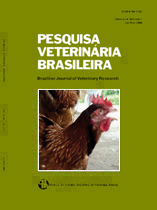 |
|
|
|
Year 2013 - Volume 33, Number 5
|

|
Serological prevalence of Toxoplasma gondii in water buffaloes (Bubalus bubalis) in Marajó Island, State of Pará, Brazil, 33(5):581-585
|
ABSTRACT.- Silva J.B., Fonseca A.H., Andrade S.J.T., Silva A.G.M., Oliveira C.M.C. & Barbosa J.D. 2013. [Serological prevalence of Toxoplasma gondii in water buffaloes (Bubalus bubalis) in Marajó Island, State of Pará, Brazil.] Prevalência de anticorpos anti-Toxoplasma gondii em búfalos (Bubalus bubalis) no Estado do Pará. Pesquisa Veterinária Brasileira 33(5):581-585. Laboratório de Imunodiagnóstico, Departamento de Patologia Veterinária, Facudade de Ciências Agrárias e Veterinárias, Universidade Estadual Paulista (Unesp), Via de Acesso Prof. Paulo Donato Castellane s/n, Jaboticabal, SP 14884-900, Brazil. E-mail: jenevaldo@hotmail.com
The aim was to study the seroprevalence of Toxoplasma gondii in water buffaloes (Bubalus bubalis) from State of Pará, Brazil. Three hundred and nineteen buffaloes were randomly selected into seven municipalities of Marajó Island. For comparative purposes, 128 buffaloes of five municipalities in the state of Pará were also evaluated. The seroprevalence of T. gondii was evaluated by Indirect Enzyme Linked Immunosorbent Assay (iELISA). The samples diagnosed as positive in iELISA were subjected to Immunofluorescence Antibody Test (IFAT). We evaluated risk factors: location, breed, pregnancy and co-infection with Brucella abortus or Mycobacterium bovis. The frequency of animals positive for T. gondii in iELISA were compared by chi-square (χ2) with 95% confidence. Variables with p <0.2 were subjected to logistic regression analysis; the model was built based on the “odds ratios” test. The prevalence of T. gondii in iELISA was 41,6% (186/447). In IFAT, 86,5% (161/186) had their positivity for T. gondii confirmed. The average prevalence in the municipalities of the Marajó Island and of the mainland was 32% (103/319) and 55% (70/128), respectively. The municipalities with the highest prevalence were Soure (53%) and Salvaterra (49%) in Marajó Island, and Castanhal (55%) and Thailândia (50%) in the Continent. The breed and co-infection with Brucella abortus or Mycobacterium bovis presented no influence on the prevalence of T. gondii. Additionally, pregnant animals were 57% more positive for T. gondii than nonpregnant animals. The presence of antibodies is an indicative of T. gondii in buffaloes in the state of Pará, and these findings represent a risk not only for farm animals, but to public health as a source of infection. |
| |
|
|
| |
|
 |